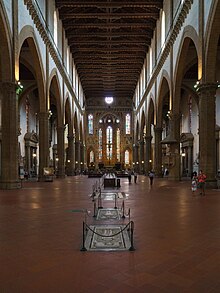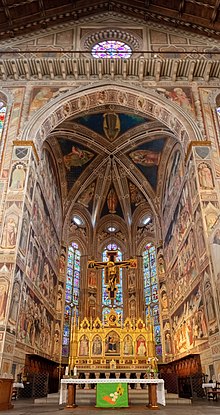Santa Croce, Florence
| Basilica of the Holy Cross | ||
|---|---|---|
Basilica di Santa Croce ( Style Gothic, Renaissance, Gothic Revival | | |
| Groundbreaking | 1294–1295 | |
| Completed | 1385 | |
| Administration | ||
| Archdiocese | Archdiocese of Florence | |
The Basilica di Santa Croce (
Building

The basilica is the largest Franciscan church in the world. Its most notable features are its sixteen
The Primo Chiostro, the main cloister, houses the Cappella dei Pazzi, built as the chapter house, completed in the 1470s. Filippo Brunelleschi (who had designed and executed the dome of the Duomo) was involved in its design which has remained rigorously simple and unadorned.
In 1560, the
The bell tower was built in 1842, replacing an earlier one damaged by lightning. The
In 1866, the complex became public property, as a part of government suppression of most religious houses, following the wars that gained Italian independence and unity.[4][5]
Among the 19th-century restorations, the 16th-century altars and plaster were removed from the Bardi Chapel, revealing Giotto's frescoes of the Life of St Francis, which include the Death of St. Francis. This painting, missing sections where an altar had been attached to the wall, was heavily restored in the 19th century. These restorations were later removed to reveal those areas which are definitively Giotto's, leaving portions of the painting missing.[6]
The Museo dell'Opera di Santa Croce is housed mainly in the refectory, also off the cloister. A monument to Florence Nightingale stands in the cloister, in the city in which she was born and after which she was named. Brunelleschi also built the inner cloister, completed in 1453.
In 1940, during the safe hiding of various works during World War II, Ugo Procacci noticed the Badia Polyptych being carried out of the church. He reasoned that this had been removed from the Badia Fiorentina during the Napoleonic occupation and accidentally re-installed in Santa Croce.[7] Between 1958 and 1961, Leonetto Tintori removed layers of whitewash and overpaint from Giotto's Peruzzi Chapel scenes to reveal his original work.[1]
In 1966, the Arno River flooded much of Florence, including Santa Croce. The water entered the church bringing mud, pollution and heating oil. The damage to buildings and art treasures was severe, taking several decades to repair.
Today the former dormitory of the Franciscan friars houses the Scuola del Cuoio (Leather School).[8] Visitors can watch as artisans craft purses, wallets, and other leather goods which are sold in the adjacent shop.
-
First Cloister with the Cappella dei Pazzi (1440s-70s)
-
The Greater Cloister
-
A gate in the gardens with the letters "OPA" for ora pro animis ("pray for souls")
Restoration
The basilica has been undergoing a multi-year restoration program with assistance from Italy's civil protection agency.[9] On 20 October 2017, the property was closed to visitors due to falling masonry which caused the death of a tourist from Spain.[10][11] The basilica was closed temporarily during a survey of the stability of the church.[12][13] The Italian Ministry of Culture said that "there will be an investigation by magistrates to understand how this dramatic fact happened and whether there are responsibilities over maintenance."
Art

Artists whose work is present in the church include (for funerary monuments see below):
- Benedetto da Maiano: pulpit; with his brother Giuliano: doors to Cappella dei Pazzi
- Cimabue: Crucifix, badly damaged by the 1966 flood and now in the refectory
- Andrea della Robbia: altarpiece in Cappella Medici
- Luca della Robbia: glazed terracotta decoration of Cappella dei Pazzi
- Desiderio da Settignano: frieze in Cappella dei Pazzi
- Donatello: Cavalcanti Annunciation on the south wall; crucifix in the lefthand Cappella Bardi di Vernio; St Louis of Toulouse in the refectory (originally made for Orsanmichele)
- Agnolo Gaddi: fresco cycle of The Legend of the True Cross in the apse with stained glass windows designed by him (1385–1387); fresco decoration of the Cappella Castellani with scenes of the lives of SS Anthony the Great, John the Baptist, John the Evangelist and Nicholas (1385)
- Baroncelli Chapel; Crucifixion in the sacristy; Arbor vitae with the Last Supper in the refectory (c. 1330–40 or –60), considered his best work
- Giotto: frescoes in Cappella Peruzzi and righthand Cappella Bardi; possibly Coronation of the Virgin, altarpiece in the Baroncelli Chapel, also attributed to Taddeo Gaddi
- Giovanni da Milano: frescoes in Cappella Rinuccini) with Scenes of the Life of the Virgin and the Magdalen
- Maso di Banco: frescoes in Cappella Bardi di Vernio) depicting Scenes from the life of St. Sylvester (1335–1338)
- Henry Moore: statue of a warrior in the Primo Chiostro
- Andrea Orcagna: frescoes largely disappeared during Vasari's remodelling, but some fragments remain in the refectory
- Antonio Rossellino: relief of the Madonna del Latte (1478) in the south aisle
- Santi di Tito: Supper at Emmaus and Resurrection, altarpieces in the north aisle
- Giorgio Vasari: Way to Calvary
- Domenico Veneziano: SS John and Francis in the refectory
Once present in the church's Medici Chapel, but now split between the Florentine Galleries and the
-
Giotto's Death of St. Francis (early 1320s) with overpainting removed
-
Taddeo Gaddi, Stories of the Virgin (c. 1330), Baroncelli chapel, north wall
-
Taddeo Gaddi, Arbor vitae (c. 1330–40 or –60), refectory
-
Agnolo Gaddi, Legend of the True Cross (1385–1387), north wall of the apse
-
Agnolo Gaddi, Legend of the True Cross (1385–1387), south wall of the apse
-
High altar with a Madonna by Niccolò Gerini, and the Doctors of the Church by Giovanni del Biondo and an unknown hand (14th ct.)
-
Donatello, Cavalcanti Annunciation (c. 1433–35)
-
Giorgio Vasari, Way to Calvary and Christ Meeting with Veronica, 1568–72, Buonarroti altar
Funerary monuments
The basilica became popular with Florentines as a place of worship and patronage and it became customary for greatly honoured Florentines to be buried or commemorated there. Some were in chapels "owned" by wealthy families such as the Bardi and Peruzzi. As time progressed, space was also granted to notable Italians from elsewhere. For 500 years monuments were erected in the church including those to:
- Leon Battista Alberti (15th-century architect and artistic theorist)
- Giovan Vincenzo Alberti (Florentine senator and minister to first two Lorraine Grand-Dukes)
- Vittorio Alfieri (18th-century poet and dramatist) by Antonio Canova
- Eugenio Barsanti (co-inventor of the internal combustion engine)
- Lorenzo Bartolini (19th-century sculptor)
- Charlotte Napoléone Bonaparte
- Leonardo da Vinci (1919 commemorative plaque, buried in Château d'Amboise in France)
- Leonardo Bruni (15th-century chancellor of the Republic, scholar and historian) by Bernardo Rossellino
- Dante (buried in Ravenna)
- Ugo Foscolo (19th-century poet)
- Galileo Galilei
- Giovanni Gentile (20th-century philosopher)
- Lorenzo Ghiberti (artist and bronze-smith)
- Giovanni Lami
- Niccolò Machiavelli by Innocenzo Spinazzi
- Carlo Marsuppini (15th-century chancellor of the Republic of Florence) by Desiderio da Settignano
- Michelangelo Buonarroti by Giorgio Vasari with sculptures by Valerio Cioli, Iovanni Bandini, and Battista Lorenzi.[14]
- Raffaello Morghen(19th-century engraver)
- Giovanni Battista Niccolini (poet)
- Gioachino Rossini by Giuseppe Cassioli
- Bonnie Prince Charlie')
- Guglielmo Marconi (buried in his birthplace at Sasso Marconi, near Bologna)
- Enrico Fermi (nuclear physicist, memorial only - Fermi is buried in Chicago, Illinois)
Cloister monuments
-
Bernardo Rossellino, Monumental tomb for Leonardo Bruni, 1445–50
-
Desiderio da Settignano, Memorial Tomb for Carlo Marsuppini, 1453–55
-
Galileo's tomb
-
Michelangelo's tomb
-
Innocenzo Spinazzi, Monumental tomb of Niccolò Machiavelli, 1787
-
Memorial tomb of Vittorio Fossombroni (1754–1844), Santa Croce, Florence
-
Cenotaph for Dante, 1829
In literature
- Romola (1863), George Eliot
- E.M. Forster, Chapter 2
- Hannibal (1999), Thomas Harris, Chapter 35
See also
- History of medieval Arabic and Western European domes
- History of Italian Renaissance domes
- History of early modern period domes
References
Footnotes
- ^ A 20th-century restoration by Leonetto Tintori revealed that the Peruzzi Chapel scenes were painted in tempera on dry plaster rather than true fresco.[1]
Citations
- ^ ISBN 0-900658-15-0.
- ^ Chiarini, Gloria (2007). "Basilica of Santa Croce". Florence Art Guide. Archived from the original on 29 July 2007. Retrieved 2007-07-30.
- ^ Cuminetti, Vittorio; Bonechi, Giampaolo, eds. (1969). Florence: Glory of the Art. Bonechi Editore. p. 39.
- ^ Besse, J M (1911). "Suppression of Monasteries in Continental Europe: C. Italy". Catholic Encyclopedia. New Advent. Archived from the original on 5 September 2007. Retrieved 2007-07-30.
- ^ "Santa Croce: Overview". Opera of Santa Croce. Archived from the original on 28 August 2007. Retrieved 2007-07-30.
- ISBN 0-15-503769-2.
- ISBN 0-900658-15-0.
- ^ http://www.leatherschool.com Archived 2006-08-13 at the Wayback Machine
- ^ "Tourist killed by falling masonry at famous Florence church". The Daily Telegraph. Associated Press. October 20, 2017. Retrieved February 2, 2018.
- ^ Agency (October 19, 2017). "Florence tourist death: Falling masonry kills Spanish visitor to Basilica di Santa Croce". The Independent. Retrieved February 2, 2018.
- UPI. Retrieved February 2, 2018.
- ^ "Tourist killed by falling masonry in famous Florence church". The Guardian. Milan. Associated Press. October 29, 2017. Retrieved February 2, 2018.
- Corriere.it. Retrieved February 2, 2018.
- ^ Borsook, Eve (1991). Vincent Cronin (ed.). The Companion Guide to Florence, 5th Edition. HarperCollins; New York. pp. 100–104.
External links
![]() Works related to Catholic Encyclopedia (1913)/Suppression of Monasteries in Continental Europe at Wikisource
Works related to Catholic Encyclopedia (1913)/Suppression of Monasteries in Continental Europe at Wikisource
- Official website
- Church and Museum of Santa Croce on the private website for tourism, Museumsinflorence.com
- BBC video about Giotto frescoes in the Basilica of Santa Croce, Florence



















